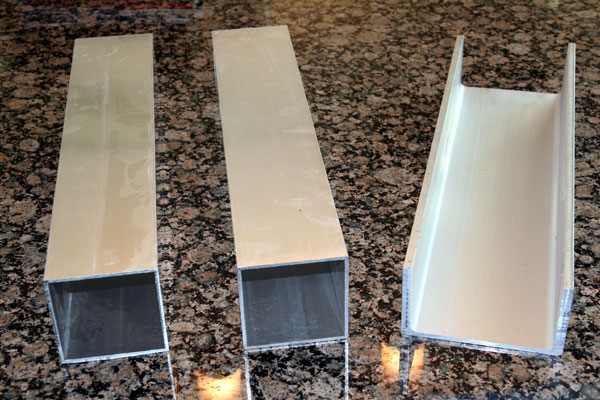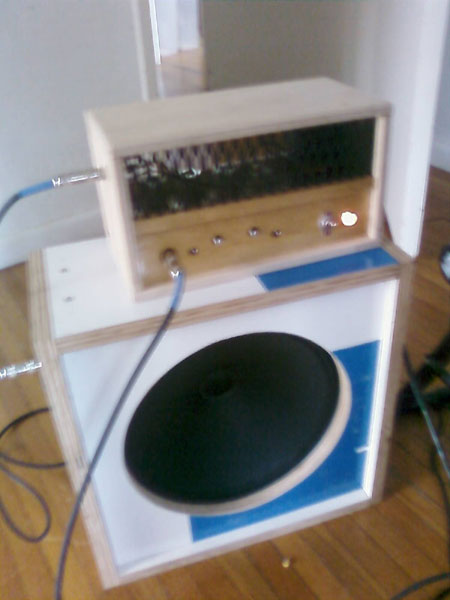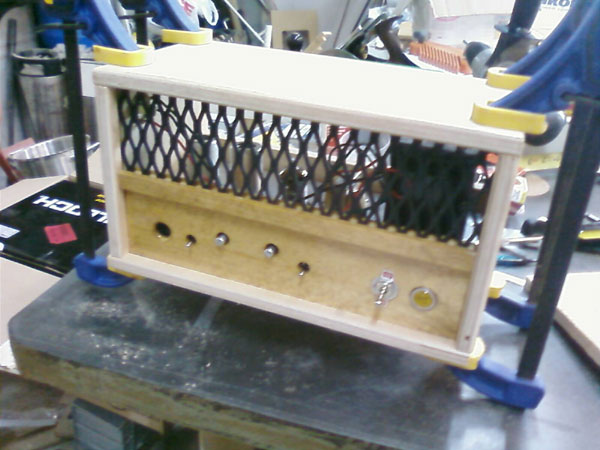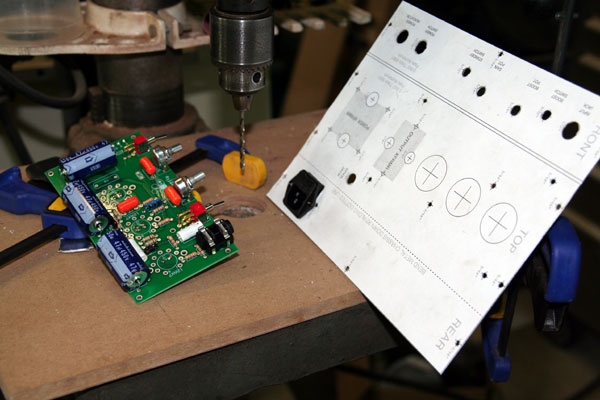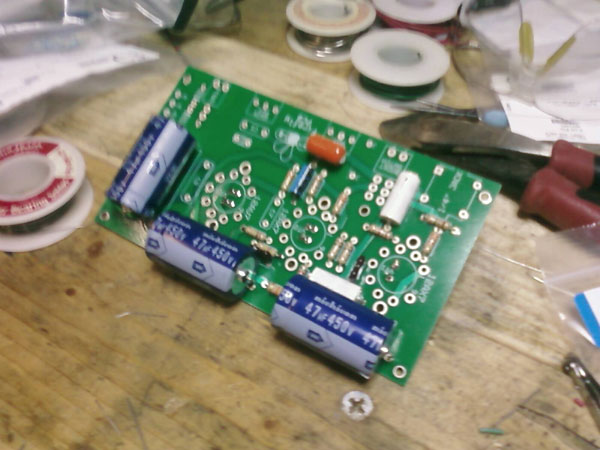Notice: No “Stairway to Heaven”
Friday, June 3rd, 2011My Loss is Heaven’s “Gain”
I guess I should post an update on my amplifier.
I decided to make a Fender Bassman clone. I got all the parts except for the chassis. A new Chinese chassis which doesn’t look too good runs something like $50 plus shipping, and I thought that was stupid. If I’m going to shell out that kind of cash for a piece of bent metal, the quality should be good.
Naturally, I decided to do things the hard way.
Here are the pieces of surplus structural aluminum I bought. Two are 4″ square tubing with 1/8″ walls. The third–this is really cool–is 6″ Aluminum Association channel. “Aluminum Association” means the walls are not tapered. The inner surfaces are parallel to the outer surfaces. This makes it easier to mount stuff in the channel.
The tubing is thin and easy to work with. The channel is very thick, and it poses a lot of problems.
Naturally, I decided to do things the hard way.
I’ll put that on my tombstone.
I am using the channel, with the long side up. The transformers and choke will be mounted above it. Actually, the power transformer is sunk into it, because that’s how you mount them. But most of it is up top.
Here is the tube layout I’m considering. The rectifier is hidden away from the other tubes, and the 12AY7 (the most sensitive preamp tube) is way down there by itself, far from the noise. I hope. Someone pointed out that using a triangular layout may make it difficult to wire the circuit board, but it’s so cute, I think I’m willing to put up with that.
The eyelet board, which I have not made, will be under it. The knobs and stuff will go through the front wall. The whole thing will sit in a wooden cabinet which I have not built yet.
This thing is monstrously rigid. If I mount it in 3/4″ plywood, it will be like a Sherman tank with input jacks. It weighs around 6.5 pounds, contrasted with roughly 3.5 for the tubing.
I don’t care about the weight. This is a head, not a combo. It won’t have a ton of speaker attached to it. If it weighs 15 pounds instead of 12, who cares?
I was able to trim it to an accurate size using the table saw. You have to love that.
I have to figure out how to polish the aluminum on the front and top. I considered using a fly cutter on the top, but my vise is like 6″ wide, and this thing is 20″ long. I don’t know if the vise will hold it firmly enough for fly-cutting. I may end up using an orbital sander.
You may be asking yourself (if you’re still here) why I’m making a head. Simple. I want to make one amp every month. If I put speakers in all of them, it will cost $900,000 a year, and they won’t be all that portable. If I use a couple of interchangeable cabinets, I’ll save a lot of cash and work, and I’ll be able to take my heads around and play them through my 1 x 12 cabinet.
By the way, here it is, all finished. Or at least it WILL be here, as soon as my camera’s battery charges. I might add a few more touches, but this is basically it. I chose not to cover the cheesy sign paint. I thought that added an extra layer of testosterone or something. The edges are all radiused, and it has big rubber feet. It’s very stiff. You can sit on it all day. By using variable-output power transformers, I’ll be making heads that can be played through this high impedance with no problems. This sure beats carrying a 4 x 10 combo every time I want to use the amp.
The channel is causing new problems every day. Last night I realized I may have problems with the potentiometers, because the metal is so thick. The shafts have to go through it. I may have to order new pots. The other answer is to mill down the front face. I would have to do this from inside the channel in order to avoid it looking like an abortion. Another option: Forstner bits and an angled drill, to make small cavities for the pots to sit in. And of course, I have no angled drill. Yet.
I think I can mill the front down using a straight end mill and holding the channel on its back in my vise. I only need about 1.5″ of thin area. It might work. Depends on how much the aluminum likes being milled that way. It may flex around and drive me crazy.
I’m going to need legend plates. I don’t want to make a nice amp and then use a P-Touch for the labels. I need to find a local place that makes the plates cheap. Prices on the web are completely mental.
I got some neat videos to help me along. A guy named Gerald Weber has a video on understanding tube amps, and he also has one on servicing and maintaining them. I’m still burrowing through the first one. It’s helping me understand what I’m working on. Some of the things he says about electronics are a little dubious, but maybe that means he learned by doing instead of learning by watching someone scrawl on a chalkboard.
In case you doubt his wisdom, here is a video that proves he’s a real pro:
My buddy from church initially wanted me to help him with a Super Reverb clone, but now he’s talking about a Dumble Steel String Singer. Unfortunately, Mr. Dumble pours epoxy into his amps to hide the circuitry and prevent people from determining exactly how much unicorn poop he puts in there, so there aren’t a whole lot of schematics out there.
He has also been talking about building a Bassman AND a Super Reverb and using them together, like this Youtube guy. I can’t argue. They sound great.
I’m also fantasizing about building a Herzog. This is the effect used in the original “American Woman.” Turns a guitar into an organ. Pedals make this sound now, but I don’t know whether they do it well. In case you care, it turns out a Herzog is just a Fender Champ rigged up so it won’t blow up your main amp when you use it as an effect.
I can’t believe I’m getting to do all this stuff. Finally the torture I inflicted on myself by getting a physics degree is paying off. Sort of. Anyway, Psalms 37:4.
The guitar playing is going well, but the amps are taking time away from it. That’s why I want to get this thing DONE. I love my cheap Epiphone Riviera P93 more every day; I still can’t believe it turned out to be so great. On the day when I bought it, I seriously felt as though the Holy Spirit told me to go to Guitar Center and pick it up, so I made a left turn and did it. When I bought it, it had shortcomings. The pickups were pretty lame, and the tone capacitor was not right. Now it’s a monster. Great tone and super-low buzz-free action. And the size and weight make it stable for fast picking.
I play mostly through my homemade Firefly amp now. The sound level is perfect. I adjusted the tone using a new capacitor, and it worked out very well. I still have oscillation when I use the gain circuit. I have to fix that.
I picked up a Blues Driver. Very nice pedal. I gravitate toward the Blues Driver, Plimsoul, and Fat Sandwich more than my other two pedals.
That’s how things stand at the moment. Updates will be posted when I feel like it.
